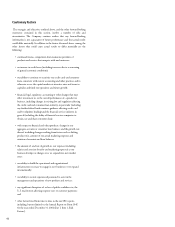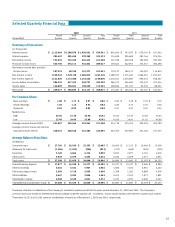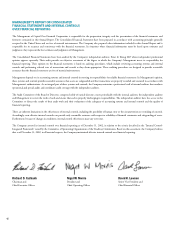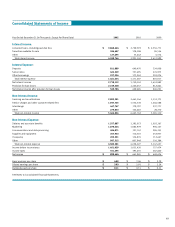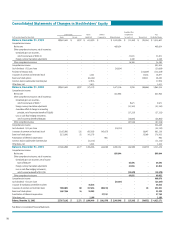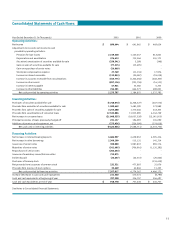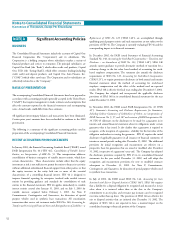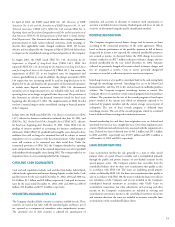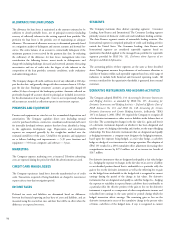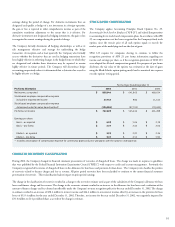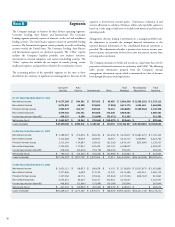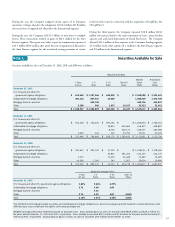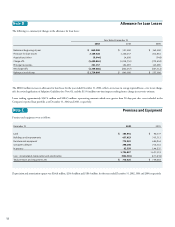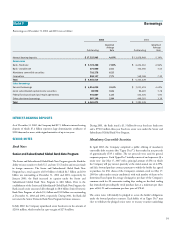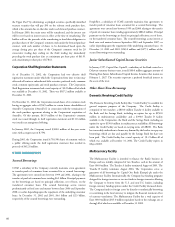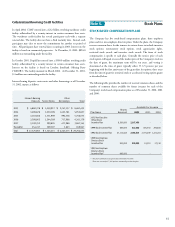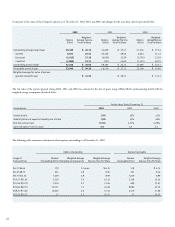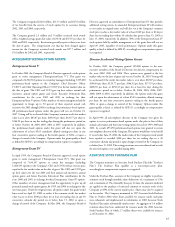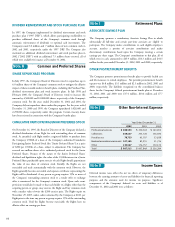Capital One 2002 Annual Report Download - page 56
Download and view the complete annual report
Please find page 56 of the 2002 Capital One annual report below. You can navigate through the pages in the report by either clicking on the pages listed below, or by using the keyword search tool below to find specific information within the annual report.
54
SEGMENTS
The Company maintains three distinct operating segments: Consumer
Lending, Auto Finance and International. The Consumer Lending segment
primarily consists of domestic credit card and installment lending activities.
The Auto Finance segment consists of automobile lending activities. The
International segment is comprised primarily of credit card lending activities
outside the United States. The Consumer Lending, Auto Finance and
International segments are considered reportable segments based on
quantitative thresholds applied to the managed loan portfolio for reportable
segments provided by SFAS No. 131, Disclosures about Segments of an
Enterprise and Related Information.
The accounting policies of these segments are the same as those described
above. Management measures the performance of and resource allocation to
each line of business within each reportable segment based on a wide range of
indicators to include both historical and forecasted operating results. All
revenue considered for the quantitative thresholds is generated from external
customers.
DERIVATIVE INSTRUMENTS AND HEDGING ACTIVITIES
The Company adopted SFAS No. 133, Accounting for Derivative Instruments
and Hedging Activities, as amended by SFAS No. 137, Accounting for
Derivative Instruments and Hedging Activities – Deferral of Effective Date of
FASB Statement No. 133, and SFAS No. 138, Accounting for Certain
Derivative Instruments and Certain Hedging Activities, (collectively, “SFAS
133”) on January 1, 2001. SFAS 133 required the Company to recognize all
of its derivative instruments as either assets or liabilities in the balance sheet at
fair value. The accounting for changes in the fair value (i.e., gains and losses)
of a derivative instrument depends on whether it has been designated and
qualifies as part of a hedging relationship and, further, on the type of hedging
relationship. For those derivative instruments that are designated and qualify
as hedging instruments, a company must designate the hedging instrument,
based upon the exposure being hedged, as a fair value hedge, a cash flow
hedge or a hedge of a net investment in a foreign operation. The adoption of
SFAS 133 resulted in a 2001 cumulative-effect adjustment decreasing other
comprehensive income by $27.2 million, net of an income tax benefit of
$16.7 million.
For derivative instruments that are designated and qualify as fair value hedges
(i.e., hedging the exposure to changes in the fair value of an asset or a liability
or an identified portion thereof that is attributable to a particular risk), the
gain or loss on the derivative instrument as well as the offsetting loss or gain
on the hedged item attributable to the hedged risk is recognized in current
earnings during the period of the change in fair values. For derivative
instruments that are designated and qualify as cash flow hedges (i.e., hedging
the exposure to variability in expected future cash flows that is attributable to
a particular risk), the effective portion of the gain or loss on the derivative
instrument is reported as a component of other comprehensive income and
reclassified into earnings in the same period or periods during which the
hedged transaction affects earnings. The remaining gain or loss on the
derivative instrument in excess of the cumulative change in the present value
of future cash flows of the hedged item, if any, is recognized in current
ALLOWANCE FOR LOAN LOSSES
The allowance for loan losses is maintained at the amount estimated to be
sufficient to absorb probable losses, net of principal recoveries (including
recovery of collateral), inherent in the existing reported loan portfolio. The
provision for loan losses is the periodic cost of maintaining an adequate
allowance. The amount of allowance necessary is determined primarily based
on a migration analysis of delinquent and current accounts and forward loss
curves. The entire balance of an account is contractually delinquent if the
minimum payment is not received by the payment due date. In evaluating
the sufficiency of the allowance for loan losses, management takes into
consideration the following factors: recent trends in delinquencies and
charge-offs including bankrupt, deceased and recovered amounts; forecasting
uncertainties and size of credit risks; the degree of risk inherent in the
composition of the loan portfolio; economic conditions; credit evaluations
and underwriting policies.
The Company charges off credit card loans (net of any collateral) at 180 days
past the due date, and generally charges off other consumer loans at 120 days
past the due date. Bankrupt consumers’ accounts are generally charged-off
within 30 days of receipt of the bankruptcy petition. Amounts collected on
previously charged-off accounts related to principal are included in recoveries
for the determination of net charge-offs. Costs to recover previously charged-
off accounts are recorded as collection expense in non-interest expenses.
PREMISES AND EQUIPMENT
Premises and equipment are stated at cost less accumulated depreciation and
amortization. The Company capitalizes direct costs (including external
costs for purchased software, contractors, consultants and internal staff costs)
for internally developed software projects that have been identified as being
in the application development stage. Depreciation and amortization
expenses are computed generally by the straight-line method over the
estimated useful lives of the assets. Useful lives for premises and equipment
are as follows: buildings and improvements — 5-39 years; furniture and
equipment — 3-10 years; computers and software — 3 years.
MARKETING
The Company expenses marketing costs as incurred. Television advertising
costs are expensed during the period in which the advertisements are aired.
CREDIT CARD FRAUD LOSSES
The Company experiences fraud losses from the unauthorized use of credit
cards. Transactions suspected of being fraudulent are charged to non-interest
expense after a sixty-day investigation period.
INCOME TAXES
Deferred tax assets and liabilities are determined based on differences
between the financial reporting and tax bases of assets and liabilities, and are
measured using the enacted tax rates and laws that will be in effect when the
differences are expected to reverse.


